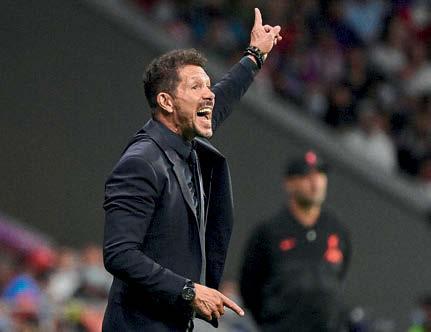
7 minute read
The grass is getting greener
Union Saint- Gilloise
Observers of the Belgian First Division will be well aware that Union Saint-Gilloise –in their first top-flight season for 48 years – are flying high in the league. But they are also setting standards when it comes to their environmental approach.
“We started out with quick wins; things that would make a big impact that we could change or implement immediately without impacting the fan experience,” says Raphaele Moeremans, the club’s head of sustainability. “It was always important for the fans to support us in the journey.”
Examples of this include the club’s introduction of eco-cups to reduce the amount of single-use plastics on match days, switching the stadium to a 100 per cent renewable energy plan, using green products to clean the stadium and facilities, replacing conventional toilet paper with recycled paper, and using soap dispensers made from recycled plastics.
“We want to lead by example,” Moeremans explains. “We have an important role to play in promoting environmental responsibility, and we are in a unique position to be able to engage with audiences that may not be reached by messaging otherwise. We believe we have a duty to show that small changes can make a big difference.”
Of course, big changes can make an even bigger difference, and the club hasn’t shied away when it comes to overhauling out-dated methods and processes. A high-tech hybrid pitch has been installed, which mixes synthetic and real grass, thereby requiring less heating in the winter and less irrigation in the summer. Union have also committed to achieving net-zero emissions by 2040, and have introduced a number of sustainable transport initiatives, such as increasing the number of secured bike parking places and giving fans reduced price public transport tickets.
“We have lots of plans for the future, including carbon neutrality and making our supply chain sustainable and fair,” Moeremans adds. “We’ve had very positive returns on our initiatives so far.”
Sustainable…Union’s Stade Joseph Marien
Forest Green Rovers
No article about environmentalism in football would be complete without the League Two side, who are Green by name and green by nature.
The club, whose chairman Dale Vince is often described as an “eco-industrialist ”, is widely regarded as the greenest on the planet. In 2018 the UN declared FGR to be the world’s first carbon-neutral football club, praising its vast array of sustainable initiatives and practices, from the installation of solar panels to the banning of meat products at the stadium.
The club is determined to make environmental statements wherever it can, and has an “organic” pitch that is completely free from chemical pesticides, provides EV charging for visitors, and in 2021 played in a kit made from discarded coffee grounds and recycled plastic.
The club’s owners are also incredibly tech-savvy, introducing a solar-powered robot to cut its grass, going some way to showcasing the club’s pioneering spirit. The EFL has also given the thumbs up to “Eco Park”, a proposed 5,000-capacity arena that would see FGR’s home games take place at the world’s greenest stadium.
Eco Park…FGR’s projected new home
zaha-hadid.com

Manchester Utd
Tottenham currently top the Premier League’s sustainability table, with United tied in second alongside Brighton & Hove Albion and Arsenal.
The Red Devils have recorded 12 consecutive years of reduction in carbon emissions, cut energy usage by 31 per cent since 2008, and became the first UK sports organisation to achieve the Carbon Trust Standard certification for their commitment to carbon reduction.
“We have a zero waste to landfill policy, we recycle around 388 tonnes of waste every year, and convert another 674 tonnes into energy,” Kate Lowe, Manchester United’s Manager of Communications, tells Wor ld Soccer. “We’ve also replaced plastic bags with paper bags in our Megastore, which equates to a reduction of 180,000 plastic bags being used every year.”
The club also has a Sustainable Procurement Policy that identifies and ultimately favours suppliers deemed to be environmentally responsible. The club also works closely with Renewable Energy Group, a company that produces eco-friendly, bio-based fuels that minimise carbon emissions.
Borussia Dortmund are making huge waves in terms of their sustainability efforts.
Like fellow Germans Wolfsburg (opposite), one of their key goals is to reduce their carbon output, including emissions generated by individuals travelling to and from the stadium. One of the club’s key initiatives is to provide all-season ticket holders with free train travel throughout all of North Rhine-Westphalia. In terms of distance, an equivalent offer would allow a Chelsea season ticket holder living in Manchester to get to London for free.
“In the short term, we want to develop smart targets for each area of work,” explains Xi Wang, Borussia Dortmund’s internal communications manager. “This includes climate neutrality, which we must achieve in the longer term. We have completed an energy consumption analysis and are using this to develop measures for the energy modernisation of our properties. With our foundation we were also able to start our first ecological education project.
“Sustainability is the cornerstone of our future – not only in football,” Xi adds.
Borussia Dortmund
Wolfsburg
The German side’s kit, badge and stadium are all green, so it should come as no surprise that environmentalism is a core part of the club’s personality.
Wolfsburg were the first Bundesliga side to use only LED floodlights, use recycled paper and sustainable office supplies, and have used 100 per cent green electricity since 2011. In recent months, the club’s e-charging infrastructure has been expanded, allowing both players and employees to charge all-electric Volkswagen cars on site.
The club’s determination to showcase their focus on sustainability has resulted in the installation of a “Race to Zero” countdown clock in the stadium, which is ticking down to 2025, when the club plans to achieve net zero emissions. “This draws the attention of fans, partners and sponsors to our race,” explains Nico Briskorn, Wolfsburg’s director of corporate social responsibility.
Yet the majority of Wolfburg’s associated carbon footprint comes from fan mobility. Briskorn admits that, while the club “can’t dictate to spectators how they should travel to and from games”, it does bear “a share of the responsibility” for the emissions generated in the process. As a result, Wolfsburg are trying to encourage fans to choose environmentally friendly transportation. Currently, a ticket to a women’s or Under-23s’ match doubles up as a free pass on public transport, with a “climate-neutral ticket” soon to be introduced for the men’s team.
“Clubs in the top leagues have the necessary resources to lead the way in a sustainable form of soccer operations,” Briskorn says. “Club leaders should therefore recognise and seize the opportunity for green, transformative soccer.”

Qatar 2022

Qatar’s bid for the World Cup has been beset by criticism ever since it was launched. While significant questions remain over the death of migrant workers in building the stadia, organisers have been robust in response to concerns over the tournament’s environmental impact.
“Sustainability is at the heart of the FIFA World Cup 2022, ” Abdulrahman Al Muftah, sustainability and environment specialist for the supreme committee for delivery and legacy, tells World Soccer.
Qatar’s eight new stadiums, the 40+ training sites and its enhanced national transport network – including the new Doha Metro – have all been built according to robust green building standards.
“Our vision of a carbon-neutral World Cup will be achieved by measuring, mitigating and offsetting all greenhouse gas emissions associated with the tournament since winning the bid in 2010, ” Al Muftah explains. “That includes infrastructure associated with the tournament’s operations, such as emissions from fan travel, accommodation, and food and beverage operations.
“In doing so, we will catalyse low-carbon solutions in Qatar and the region, and drive



Sustainability In Numbers
90% Of football warming a fans are in favour of protec nd reducing pollution ting the environment, fighting global
86% Of fans believe the f protection, and say ootball industry should be committed to they would be “more satisfied” if games environmen were tal environmentally friendly
69% Of fans aged 16-24 want to see clubs improve inequality, or act sustainably do more to help the community,
61% Transportation accounts car bon footprint for 61 per cent of Premier League clubs’
48% Of fans don’t believe “change anything” that altering their own behaviour would
growth in the low-carbon economy. It is our hope that the 2022 World Cup will set new benchmarks and help change the way future World Cups and other sporting events are planned, developed and delivered. ”
Qatar 2022…Al Thumama Stadium


















